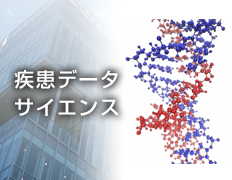In collaboration with the Department of Surgery, Osaka University (Profs. Masaki Mori and Yuichiro Doki), Ogawa et al. showed the data that cancer reprogramming may be a useful treatment for chemo- or radiotherapy-resistant cancer cells. The introduction of microRNA (miR) resulted in epigenetic reprogramming of DNA demethylation and histone modification events. In vivo administration of the ribonucleotides in mice elicited the induction of cancer cell apoptosis. The present study shows that the introduction of miRs could induce cellular reprogramming and modulate malignant phenotypes of human colorectal cancer, suggesting that the appropriate delivery of functional small-sized ribonucleotides may open a new avenue for therapy against human malignant tumors.
-
In collaboration with the Department of Surgery, Osaka University (Profs. Masaki Mori and Yuichiro Doki), Nishikawa et al. studied an expression profiling study of surgically resected human tumors by utilizing a flow cytometry-based cell separation technique, an anti-cell surface marker antibody-based array platform, and a tumorigenicity analysis in immunodeficient animals. These approaches revealed that the significance of markers cluster of differentiation CD44 and CD26. The present study demonstrated that the combined expression of CD26 and CD44 presents a potential marker of human GC stem cells.
-
The M2 isoform of pyruvate kinase, the final rate-limiting enzyme of aerobic glycolysis, is expressed during embryonic development, whereas the M1 isoform is expressed in differentiated cells due to alternative splicing. By utilizing murine embryonic stem cells (ESCs) , Konno et al showed that the Pkm2 allele plays an important role in establishing intracellular redox conditions and modulating oxidative phosphorylation events to achieve an appropriate ESC differentiation program.
-
Metabolism may determine the biologically malignant behavior of pancreatic cancer. To investigate the significance and prognostic value of cancer metabolism in cancer patients, Ogawa et al., in collaboration with the Department of Surgery, Osaka University, investigated the expression of two key enzymes in anaerobic glycolysis, hexokinase 2 (HK2) and pyruvate kinase isoenzyme type M2 (PKM2). The results demonstrated that the expression of HK2 and PKM2, particularly their combination may predict an unfavorable clinical outcome in patients with pancreatic cancer.
-
Cyclin G2: a new prognosis marker in pancreatic cancer (Oncol. Lett., 2014)
Although a family of cyclins positively regulates the cell cycle to a large extent, Hasegawa et al. found that unexpectedly cyclin G2 has been shown to regulate cell proliferation as a tumor suppressor gene, as the collaboration with the Department of Surgery, Osaka University (Profs. Nagano, Mori and Doki), Research Institute for Microbial Diseases, Osaka University (Prof. Nojima) , and Cancer Research Institute of Kanazawa University (Prof. Gotoh), Japan. The study demonstrates the candidacy of decreased CCNG2 expression as a marker for poor prognosis in pancreatic cancer.
-
Bioinformatics and computational modeling offer innovative approaches to investigate cancer metabolism and predict the secondary and tertiary cellular responses. A significant proportion of patients with glioblastoma and hematological malignancies harbor the mutated forms of the oxidative phosphorylation (OxPhos) enzymes, isocitrate dehydrogenase (IDH) 1 or 2. The mutated forms of IDH1 and IDH2 produce an oncogenic metabolite, D-2-hydroxyglutarate (D2HG). We computationally analyzed gene expression in colorectal cancer (CRC), and identified novel sets of genes that are associated with patient survival. The study of OxPhos-related genes revealed that an imbalance between the expression of IDH1 and IDH2, defined as over expression of one isoform in relation to the other, was associated with worse prognosis in CRC patients. This effect was accentuated by reduced expression of the 2-HG-inactivating pathway. These findings suggest a yet uncharacterized mechanism to discover novel therapeutic targets for the treatment of CRC.
-
In collaboration with the Department of Surgery, Osaka University (Profs. Masaki Mori and Yuichiro Doki), Hamabe et al. showed that pyruvate kinase M2 (PKM2), an alternatively spliced variant of the pyruvate kinase gene, mediates epithelial?mesenchymal transition (EMT), which is critical for aggressive cancer phenotypes. The study demonstrates that EMT stimulates nuclear translocation of PKM2 and controls transcription mechanism. The present study shows a role of pyruvate kinase M2 in transcriptional regulation leading to EMT. The precise understanding of nuclear PKM2 function suggests the potential for a model preventing metastasis of colorectal cancer.
-
Cancer stem cells of the gastrointestinal system (Review: JJCO, 44, 1141, 2014)
In collaboration with the Department of Surgery, Osaka University, Colvin et al. update the recent advances in the understanding of cancer stem cell biology in the gastrointestinal system. This review underscores the aspects of identification, origin, cell-cycle dormancy, relationship with epithelial-mesenchymal transition, cellular metabolism and the underlying molecular mechanisms.
-
In the collaboration with the Department of Radiation Oncology, Osaka University, Hayashi , et al. investigated optical imaging parameters to evaluate cancer stem cells using human cervical cancer cells. The results of a sphere-forming assay revealed that the self-renewal ability of the population was significantly high. A tumorigenicity assay confirmed the tumorigenic potential. The radioresistance and chemoresistance were confirmed. These results indicate cancer stem cell-like properties and therapeutic resistance. Thus we successfully visualized cancer stem cell-like cells using this system.
-
In the collaboration with the Department of Radiation Oncology, Osaka University, Tamari, et al. identified a subpopulation of cells with stem cell-like characteristics, such as tumor-initiating cells (TICs), which maintain the capacity to regenerate entire tumors. The study separated the osteosarcoma cells using the fluorescence-activated cell sorting (FACS)-based system and verified TIC-like properties. The present study demonstrated that chemoradiation-resistant cancer stem cells can be visualized by this system and suggested the rationale for further study of osteosarcoma stem cells.

